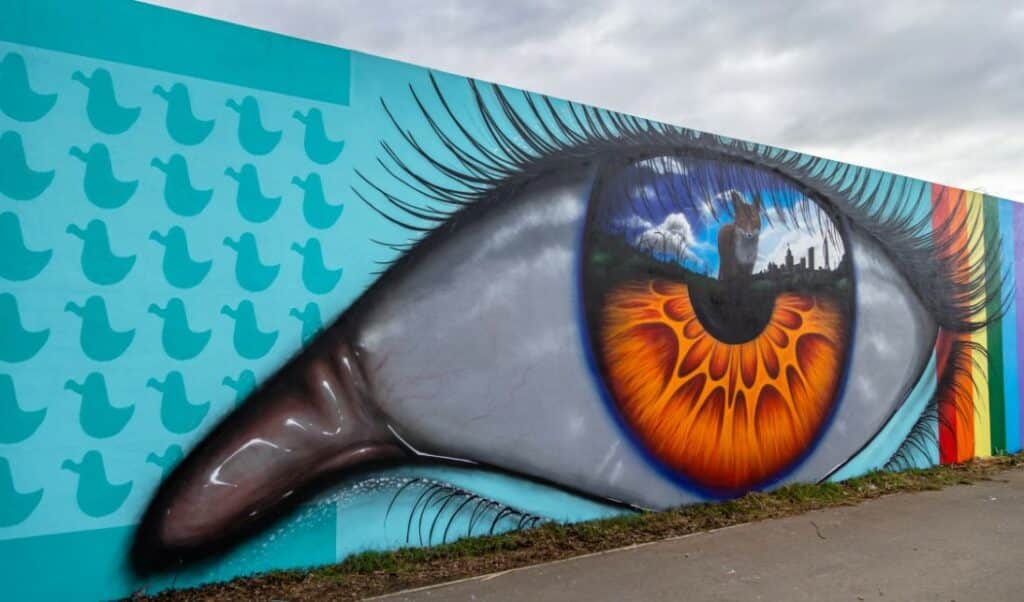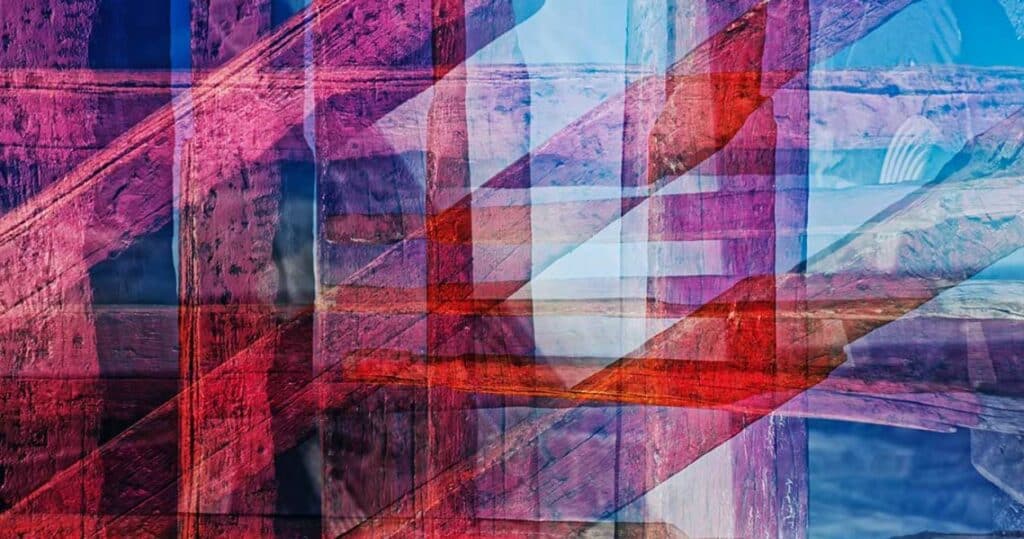“Celebrating Color, Culture, and Community: Murals that Redefined Urban Landscapes”
In this article, “The Power of Street Art: 10 Famous Murals That Transformed Urban Spaces”, we dig into the fascinating realm of street art and investigate ten extraordinary murals that have been instrumental in the alteration of urban landscapes. Each of these murals has played a key role in the development of urban landscapes. Put on your safety belts, because we’re about to embark on an artistic adventure that will blow your mind!
Street art, a lively form of self-expression, possesses the extraordinary capacity to transform dull and mundane locations into visually appealing and thought-provoking environments. This is one of the many incredible benefits of street art. Neighborhoods as a whole can be given a new lease on life and vitality through the brushstrokes of creative painters, which can captivate the eyes and hearts of people walking by.
Street art is a type of visual art that is made in public places, usually on buildings, walls, streets, and other surfaces that anyone can see. It includes many different kinds of art, such as graffiti, murals, stencils, wheat-pasting, installations, and 3D sculptures, but not just those.
10 Street Art Murals That Transformed Urban Spaces
Urban areas can be made more colorful, livable, and welcoming to a wider variety of people through the use of street art’s transformative power. The following are ten murals that have completely changed the character of urban areas around the world:
1. The Wynwood Walls in Miami

In a former warehouse area in Miami, the Wynwood Walls is an outdoor museum of street art from around the world. Along with over 50 artists from around the world, the project began in 2009 and has since added murals to buildings in the area. The Wynwood Walls have brought new life to the area and people from all over the world come to see them.
Key Aspects: The Wynwood Walls
| Aspects | Description |
| Location: | Miami, Florida, USA |
| Founding Artist: | Tony Goldman |
| Concept: | Outdoor street art museum |
| Impact: | Revitalized a neglected warehouse district |
| Artistic Styles: | Diverse range including graffiti and murals |
| Cultural Influence: | Showcases local and international artists |
2. The East Side Gallery in Berlin, Germany

The East Side Gallery is the longest piece of the Berlin Wall that is still standing. Murals drawn by artists from around the world cover it. There are a lot of different kinds of themes in the murals, from political and social comments to personal stories and messages of hope. The East Side Gallery is a powerful reminder of the Berlin Wall’s past and how art can bring people together.
Key Aspects: The East Side Gallery
| Aspects | Description |
| Location: | Berlin, Germany |
| Founding Artist: | Numerous artists collectively |
| Concept: | A preserved section of the Berlin Wall was transformed into a gallery with murals and artwork, symbolizing unity and the end of the Cold War. |
| Impact: | A powerful symbol of freedom and unity, drawing millions of visitors . |
| Artistic Styles: | Diverse range of artistic styles, from graffiti to surrealism and political commentary. |
| Cultural Influence: | Iconic representation of the fall of the Berlin Wall and the reunification of East and West Germany. |
3. The Bowery Wall in New York City, New York

City street artists have been painting on the 200-foot-long Bowery Wall on New York City‘s Bowery Street for many years. Every time a new artist comes along, they paint over the work of the other artists that came before them. The Bowery Wall is a vibrant and ever-evolving space that reflects the diversity and creativity of New York City.
Key Aspects: The Bowery Wall
| Aspects | Description |
| Location: | New York City, New York |
| Founding Artist: | Various artists over the years |
| Concept: | Rotating showcase of diverse street art |
| Impact: | Promotes cultural dialogue and expression |
| Artistic Styles: | Varied, from graffiti to contemporary |
| Cultural Influence: | Iconic site for the global street art community |
4. The Mural of Brotherhood in Belgrade, Serbia

On the side of a building in Belgrade, Serbia, there is a 2,000-square-meter painting called “The Mural of Brotherhood.” The mural shows kids from around the world having fun together. It’s a sign of peace and harmony. There is a famous street painting in the world called Brotherhood that was painted in 1961.
Key Aspects: The Mural of Brotherhood
| Aspects | Description |
| Location: | Belgrade, Serbia |
| Founding Artist: | Unknown |
| Concept: | Symbolizes unity and harmony among diverse communities |
| Impact: | Fostered a sense of inclusivity and solidarity within the city |
| Artistic Styles: | Realism, Symbolism |
| Cultural Influence: | Promoted social cohesion and understanding in a historically diverse city |
5. The Mural of the Revolution in Mexico City, Mexico

A group of paintings by Diego Rivera called “The Mural of the Revolution” can be found on the walls of Mexico City’s Palace of Fine Arts. The murals show Mexico’s past, from before the Spanish came to the country to the Mexican Revolution. One of the most famous things to see in Mexico City is the Mural of the Revolution, which is a great work of Mexican art.
Key Aspects: The Mural of the Revolution
| Aspects | Description |
| Location: | Mexico City, Mexico |
| Founding Artist: | Diego Rivera |
| Concept: | Depicts Mexico’s revolutionary history and its people’s struggles. |
| Impact: | A symbol of Mexican heritage and a powerful statement of social change. |
| Artistic Styles: | Muralism, fresco painting |
| Cultural Influence: | Influenced the Mexican muralist movement and inspired social and political art worldwide. |
6. The Wall of Hope in Belfast, Northern Ireland

The Wall of Hope is a peace wall in Belfast, Northern Ireland. It is in the Bogside neighborhood. There are murals and graffiti on the wall that talk about the past of the Troubles in Northern Ireland and ask for peace and unity. The Wall of Hope is a strong reminder of hope and strength in the face of hardship.
Key Aspects: The Wall of Hope in Belfast
| Aspects | Description |
| Location: | Belfast, Northern Ireland |
| Founding Artist: | Unknown |
| Concept: | A depiction of hope, unity, and peace |
| Impact: | Fostering a sense of community and peace |
| Artistic Styles: | Mural art, graffiti |
| Cultural Influence: | Promoting reconciliation and healing |
7. The Tribute to the Fallen Heroes in Los Angeles, California

A painting called “Tribute to the Fallen Heroes” is on the side of a building in Los Angeles, California. In the painting, the faces of 30 American soldiers who died in the Iraq War are shown. The painting is a strong reminder of how much war costs and what our troops give up for us.
Key Aspects: The Tribute to the Fallen Heroes
| Aspects | Description |
| Location: | Los Angeles, California |
| Founding Artist: | Juan Perez |
| Concept: | Honoring local heroes and veterans |
| Impact: | Fostering community unity and remembrance |
| Artistic Style: | Realism, Graffiti |
| Cultural Influence: | Commemoration of local history |
8. The Mandela Mural in Johannesburg, South Africa

The Mandela Mural is a painting of Nelson Mandela on the side of a building in Johannesburg, South Africa. It is 60 feet tall. The mural is a symbol of hope and inspiration, and it is one of the most popular tourist attractions in Johannesburg.
Key Aspects: The Mandela Mural
| Aspects | Description |
| Location: | Johannesburg, South Africa |
| Founding Artist: | Various local artists |
| Concept: | Tribute to Nelson Mandela’s legacy and activism |
| Impact: | Fosters unity and a sense of pride among locals |
| Artistic Styles: | Realism, Contemporary |
| Cultural Influence: | Symbolizes the spirit of resilience and equality |
9. The Peace Mural in Hiroshima, Japan

On the side of a building in Hiroshima, Japan, there is a painting called the Peace Mural. The painting shows a peace dove flying over the city. The dove is a sign of hope and strength in the face of nuclear destruction. One of the most famous things to see in Hiroshima is the Peace Mural.
Key Aspects: The Peace Mural
| Aspects | Description |
| Location: | Hiroshima, Japan |
| Founding Artist: | Iri Maruki and Toshi Maruki |
| Concept: | Symbolizing the quest for peace and the horrors of nuclear warfare |
| Impact: | Serves as a powerful reminder of the enduring importance of peace and the devastating consequences of war |
| Artistic Styles: | Realism, Symbolism |
| Cultural Influence: | Highlights Japan’s anti-war sentiments and serves as a global symbol of peace and remembrance |
10. The Girl with the Balloon in London, England

Banksy made a painting called “The Girl with the Balloon” that is on the side of a building in London, England. This is one of the most famous street paintings in the world. It shows a girl letting go of a heart-shaped red balloon. The Girl with the Balloon has been broken into more than once, but it has always been fixed up. The painting is a strong sign of strength and hope.
Key Aspects: The Girl with the Balloon
| Aspects | Description |
| Location: | London, England |
| Founding Artist: | Banksy |
| Concept: | Symbolizes hope and the fleeting nature of life |
| Impact: | Sparked global conversations on street art and its significance |
| Artistic Styles: | Stencil art, Graffiti |
| Cultural Influence: | Became an iconic representation of the transient beauty of life |
Street art is a way of communicating that goes beyond borders, cultures, and languages. It can change gray cityscapes into colorful, thought-provoking galleries that draw people in and make them stop and look.Read More!
These ten murals are living examples of the transformational power of street art, and they can be found all over the world, from the crowded streets of New York City to the colorful alleyways of Buenos Aires. They not only reimagine urban environments but also weave stories of resiliency, unity, and cultural diversity, giving cities, which we commonly refer to as concrete jungles, a sense of vibrancy and vitality. Through the brushwork of these painters, the commonplace is transformed into the miraculous, the remarkable into the everyday, and the pavement itself is transformed into a canvas for a global language that speaks directly to the human spirit.
FAQ
What role does street art play in urban environments?
Street art is an effective tool for both cultural expression and social reflection. It has the potential to turn underutilized or unappreciated spaces into lively, engaging venues that create community pride and identity.
How do cities usually react to the rise of street art?
The reactions of cities to street art vary greatly. While some municipalities see it as a treasured cultural asset, others see it as vandalism and may enact severe regulations prohibiting it.
What are some of the most popular subjects depicted in street art murals?
Social activism, cultural heritage, environmentalism, and personal narratives are all common topics. Street artists frequently use their work to raise public awareness about urgent social issues and to promote public dialogue and reflection.





